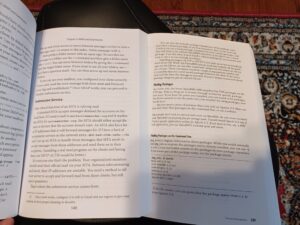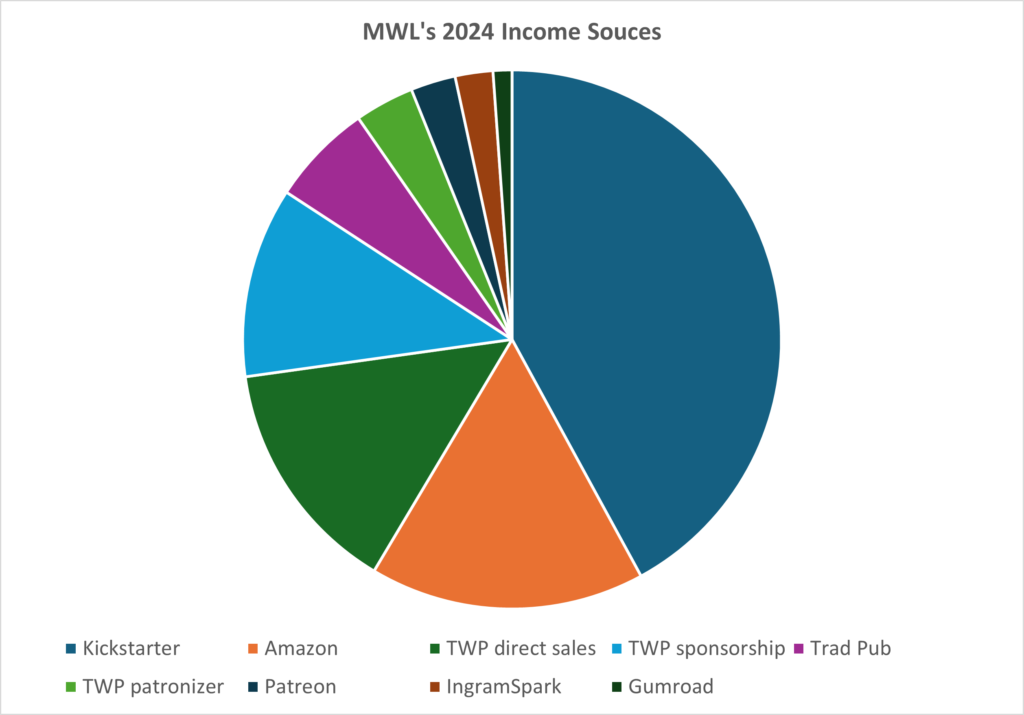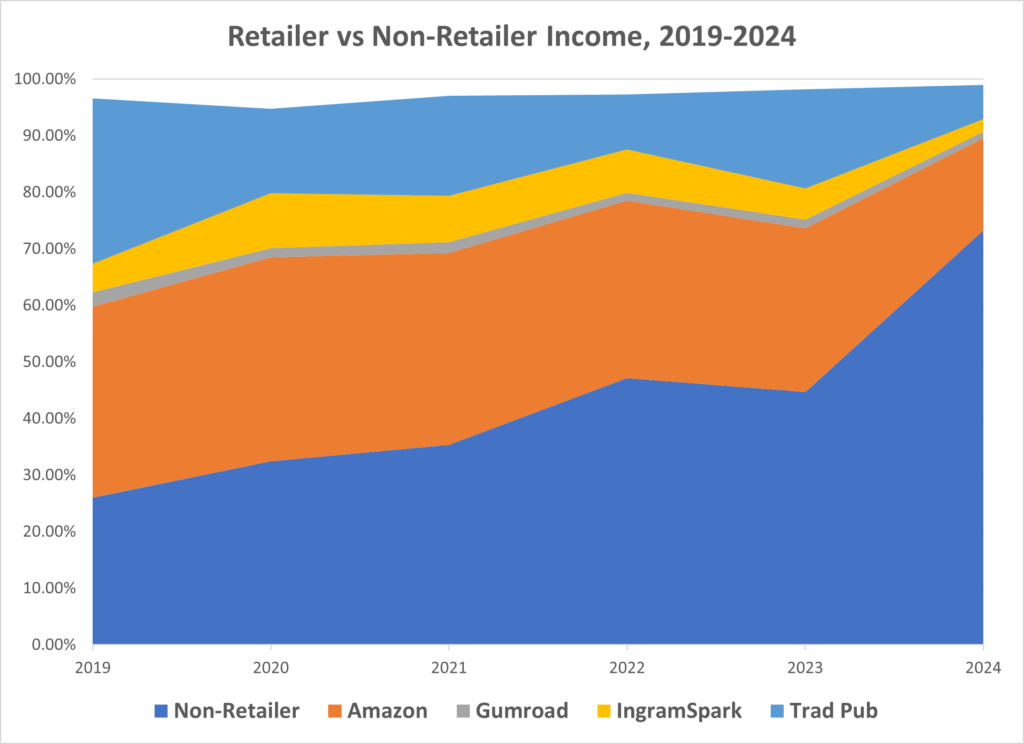(This post went to Patronizers in March, and to the public in April. Not a Patronizer? You could be.)
The business world is upended. Companies are bracing for survival. Jobs are being cut. It’s almost as if people realized that the ship of state has not only been overtaken by a great white whale, but the whale has climbed onto the deck and is thrashing about shrieking “Respect me! RESPECT ME.”
As if that could ever happen. But anyway.
There’s really only one reaction my family can have: tighten our belts, and slash spending to the bone. At the business level I’m focusing on disintermediation. Speaking of which, I have successfully disintermediated print sales for Run Your Own Mail Server, SSH Mastery, and Dear Abyss. And they’re selling. 11 copies isn’t fantastic, but these are all backlist titles more than 30 days old. Yes, RYOMS is my most recent title, but after the sponsorships and Kickstarter and my 30-day post-release marketing push, it’s now a backlist title. I hope to sell a couple dozen copies a month, if I’m lucky. Same for SSH Mastery. Dear Abyss, of course, I expect to sell zero of. Those of you daft enough to buy it have already done so. (How do I make a living by selling a couple dozen copies a month of a title? By having a lot of titles., and by offering crowdfunding. That’s you lovely Patronizers.)
Mind you, I have no ability to count how many copies of a title I sell. The dozens of sales channels I offer ebooks through all have incompatible reporting systems. No way to aggregate them. I just write the best books I can, wish them luck, kiss them goodbye, and indifferently fling them into the hungry void. What happens next is up to them.
How does the print disintermediation work?
Bookvault (BV) prints the books for me. They offer an API for ordering books and a WordPress plugin for it.
When you order a print book from me, WordPress confirms that the book is printable and what shipping options are available to your address. When you complete your order, WordPress takes your money. It then tells BV to print and ship the book, and tells BookFunnel to send you an ebook. BV will send you a notice that they’ve accepted the order, as well as when they ship from their plants in the US, UK, or Australia. The annoying thing is that BV’s receipt tells you how much I paid for the book. It’s not that I care that you know printing RYOMS costs $8. You could figure that out if you cared. But it might confuse buyers.
The catch with BookVault is that while they are a third printer. I currently print through IngramSpark and Amazon. Each requires PDF files created with very specific requirements and settings. If you’ve lived your life as a decent, wholesome person and have therefore never needed to delve into the bleak innards of the Portable Document Format, all you need to know is that there are many versions of the PDF standard, and each has many options. These settings can be saved through .joboptions files. As a printer, providing your customers with a config file is the surest way to guarantee that the PDF files you receive use the correct settings. Between all of the big POD printers, can you guess which ones provide .joboptions files?
Lulu.
Which POD printer does not appear in the list of printers I use?
Lulu!
(Why do I not use Lulu? That’s another discussion. They’re probably fine for you, but I’m a madman.)
BV can use the same interior file as Amazon and IngramSpark, but provides their own cover template. I must recreate the cover for each book. About an hour of work for each title. Then I must order a proof, wait for it to arrive, check my work, and activate it on the store. Not onerous, but definitely tedious. With the number of titles I’ve published, getting everything on BV will require time. If I can reproduce the success of the RYOMS Kickstarter, I was contemplating hiring someone for exactly this sort of work. Sadly, the flopping whale means that’s unlikely. Once I finish the current books, I need to book a couple weeks of nothing but cover recreation and get everything into BV and thus onto TWP.
Why did this take so long? As I said last month, I had to hire an outside WordPress consultant to figure out why the shipping options for sponsors and print orders were being comingled. Sleeping Giant delved into my store and came back with, “Because WooCommerce shipping is poo.” Authors who don’t do sponsorships would have no problem, but noooo, I’m a madman and have multiple shippable products that use different shipping mechanisms. Woo has many shipping options because the poo needs shoveling. It’s both a relief to know that I did nothing wrong, and that I spent nearly a year on a problem that I could not have solved because the underlying technology is flawed. Figures.
This will be left alone couple months. If there are problems, if BV can’t actually execute or shipping is awful or the flopping whale disables my ability to do business with British firms like BV, I’ll have to find another way.
I’m also waiting for someone to say “You charged $30 for a book that costs you $8? What the hell, dude?” That’s a fair question. My print books are priced to accommodate sales through bookstores, including the Dread Bezos-Beast. I sure don’t see $22 when you buy it through retail channels. I freely admit that the increased margin on direct sales is why I’ve been so desperate to disintermediate print. I can’t offer a reduced price on print books sold directly, because Amazon will match any price I set. Once I know that everything works as I hope, I might offer a coupon to help cover shipping.
Other things I’ve done this month?
I try to make all relevant information available on my web site. Between the FAQ, the books, podcast, blog, videos of talks, it’s a lot. More than one person has told me that my web site is overwhelming. I took a couple hours and set up https://mwl.link/ as a handy index of everything. What happens? If I tell folks that’s my web site, they say I need a better web site. Please imagine I’ve put one of those “exhausted crying baby” GIFs here.
Writing progress?
Five scenes remain on ProjectIDGAF, and one of them is super short. It should be complete this week. I’ll then shift into high gear on N4SA2e.
Hard to type with a whale rocking the whole dang ship, though. I get seasick.



